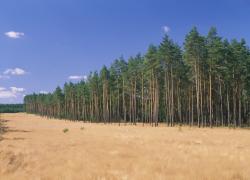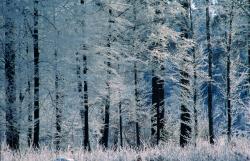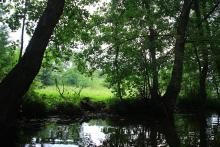 Asset Publisher
Asset Publisher
Polish forests
Poland is in the European lead, while concerning the area of all forests. They cover about 29,2 % of the country territory, and grow within the area of 9,1 million hectares. The overwhelming majority of the forests is state owned, of which almost 7,6 million hectares are managed by the State Forests National Forest Holding..
The number of Polish forest is still growing. The forestation rate of the country has increased from 21 % in 1945 to 29,2 % at the moment. Between 1995 and 2008, the forest area increased by 310 thousand ha. The basis for afforestation works is the "National Programme for Increasing the Forest Cover" (KPZL), assuming an increase of the forestation rate up to 30 % by 2020 and up to 33 % by 2050. Polish forests abound in flora, fauna and fungi. 65 % of the total number of animal species live there.
The forests grow in our country on poor soils, mainly because of the development of the agriculture in previous years. It influences the distribution of the types of the forest sites in Poland. Over 55 % of the forest areas is covered with coniferous forests. In other areas, there are forest sites, mainly the mixed ones. Their small part constitute alder and riparian forests – not more than 3 %.
In the years 1945 – 2011 the area of natural deciduous tree stands within the area of the State Forests National Forest Holding increased from 13 to 28,2 %.
Within the lowlands and uplands the most often occurring tee species is pine. It covers 64,3 % of the forest area of the State Forests National Forest Holding and 57,7 % of private and commune forests. In the mountains the predominant species is European spruce ( in the west) and European spruce with beech (in the east). Domination of pine is the result of carrying on sustainable forest management in the past. Once, the monocultures (crops or cultivations of one species) were the answer to the great demand of industry for wood. Such forests appeared to be quite fragile to climatic factors. They also were often the prey of pests' expansion.
In Polish forests, the share of other tree species, especially deciduous trees have been systematically increasing. The foresters have stepped aside from monocultures – that is why, they try to fit specific species of the forest stand to the natural stand, that would be proper for the given area. Thanks to that, in the years 1945 – 2011, the area of the deciduous tree stands within the lands of the State Forests National Forest Holding increased from 13 to 28,2 %. There occur more and more frequently the following tree species: oaks, ashes, maples, sycamore maples, elms, but also birches, beeches, alders, poplars, hornbeams, aspens, tilias and willows.
Our forests are the most often represented by the forest stands aged 40 to 80 years. The average age of the forest equals 60 years. More and more trees are of big size at the age over 80 years. Since the end of the Second World War, the forests' area has increased up to almost 1,85 million hectares.
Raport o stanie lasów w Polsce 2012
 Asset Publisher
Asset Publisher
SPOTKANIE DYREKTORA GENERALNEGO LASÓW PAŃSTWOWYCH
SPOTKANIE DYREKTORA GENERALNEGO LASÓW PAŃSTWOWYCH
W dniach 23-24.01.2025 r. Ośrodek Wypoczynkowy "Leśnik" odbyło się spotkanie dyrektora generalnego Lasów Państwowych, Witolda Kossa z nadleśniczymi i dykrektorami RDLP z Katowic, Poznania, Szczecina, Wrocławia i Zielonej Góry.
Dyrektor Koss zaprezentował strategiczne kierunki rozwoju Lasów Państwowych, a także podsumował 2024 rok. Zaznaczył, że, przedstawiona podczas II edycji Ogólnopolskiej Narady o Lasach, propozycja objęcia 17 proc. lasów szczególną ochroną jest propozycją policzoną i bezpieczną dla organizacji. Zwrócił uwagę na potrzebę dostosowania lasów do postępującej zmiany klimatu. Przypomniał też, że w sierpniu poprzedniego roku zakończono proces uzgadniania nowego wzoru umowy licencyjnej na certyfikację FSC. To otwiera drogę do powrotu FSC w Regionalnych Dyrekcjach Lasów Państwowych, które obecnie nie posiadają tego certyfikatu. Dużo uwagi poświęcił także bezpieczeństwu gospodarczemu organizacji.
– Ze względu na sytuacje międzynarodową, bezpieczeństwo jest teraz przewodnim tematem dyskusji publicznej. Słychać to było przedwczoraj w Parlamencie Europejskim. Bezpieczeństwo jest też tematem przewodnim Polskiej Prezydencji UE. Jako leśnicy stoimy na straży bezpieczeństwa środowiskowego, ale także gospodarczego naszego kraju. Przemysł leśno- drzewny to około 3 % PKB, wszystkie proponowane przez nas rozwiązania i zmiany związane z ważną dla leśników ochroną przyrody są bezpieczne gospodarczo – mówił podczas spotkania dyrektor Koss.
Marcin Polak, zastępca dyrektora generalnego ds. ekonomicznych omówił sytuację ekonomiczną LP.
Agnieszka Grzegorczyk, naczelniczka Wydziału Zarządzania Zasobami Ludzkimi DGLP przedstawiła wyniki kolejnego etapu prac zespołu zadaniowego, powołanego zarządzeniem DGLP nr 118 z dnia 24 września 2024 r. oraz aktualny stan jego dalszych prac. Obecnie trwają konsultacje modelu wyrównania obciążeń pracą z dyrektorami Regionalnych Dyrekcji Lasów Państwowych. Mają one na celu dopracowanie modelu, wymianę uwag i spostrzeżeń.
– Naszym priorytetem jest zrównoważenie obciążeń pracą na poszczególnych stanowiskach w jednostkach LP, w tym celu zamierzamy wdrożyć model oparty na naturalnych procesach kadrowych – mówiła Agnieszka Grzegorczyk.
Olga Buczyńska, naczelniczka Wydziału Biuro Prasowe DGLP oraz z Anna Choszcz-Sendrowska, rzeczniczka prasowa Lasów Państwowych zaprezentowały uczestnikom główne założenia strategii komunikacyjnej LP, omówiły możliwe zagrożenia wizerunkowe oraz przedstawiły rezultaty niedawnych kampanii, jednocześnie akcentując efektywność zintegrowanych działań komunikacyjnych.
Anna Pikus, naczelniczka Wydziału Społecznych Funkcji Lasu DGLP przybliżyła nadleśniczym koncepcję Centrum Dialogu Lasu Państwowych – struktury formowanej na wzór innych działów merytorycznych w naszej organizacji. Podkreśliła, jak ważną rolę w dobie dużego społecznego zainteresowania działaniami Lasów Państwowych, będą sprawowali w organizacji konsultanci do spraw kontaktów społecznych, pracujący w nadleśnictwach i regionalnych dyrekcjach LP.
Spotkania w Łagowie, zakończyły serię spotkań dyrektora generalnego z nadleśniczymi ze wszystkich regionalnych dyrekcji Lasów Państwowych. Takie spotkania będą odbywały się co roku, by osoby zarządzające naszą organizacją mogły pozyskać informacje bezpośrednio od dyrektora generalnego LP, a także wymienić się doświadczeniami i spostrzeżeniami na temat kierunków rozwoju Lasów Państwowych.


 fot. Paweł Fabijański
fot. Paweł Fabijański
 fot. Paweł Fabijański
fot. Paweł Fabijański
 fot. Paweł Fabijański
fot. Paweł Fabijański









